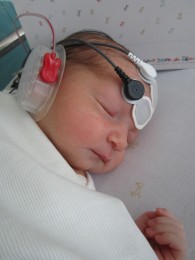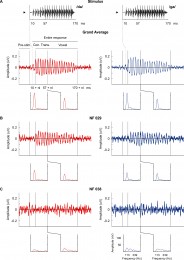The paper entitled The frequency-following response (FFR) to speech stimuli: a normative dataset in healthy newborns, by Ribas-Prats, Almeida, Costa-Faidella, Plana, Corral, Gómez-Roig, & Escera has just been published in the journal Hearing Research.

This is the first paper that comes out from the collaboration between our Brainlab at the University of Barcelona and the Obstetrics and Gynecology Department of the Sant Joan de Déu Hospital (HSJD) in Barcelona, in the context of the recently created Institut de Recerca Sant Joan de Déu (IRSJD).
In this paper, we provide the first systematic and normative description of the Frequency-Following Response (FFR) in human neonates. The FFR holds great promise as a potential biomarker for neurodevelopmental and literacy outcomes, and has been suggested as putative newborn hearing screening 2.0, and hence our data provide the first attempt to standardize in a large sample of healthy newborns a range of FFR-derived parameters.
The full abstract reads as follows:
 The Frequency-Following Response (FFR) is a neurophonic auditory evoked potential that reflects the efficient encoding of speech sounds and is disrupted in a range of speech and language disorders. This raises the possibility to use it as a potential biomarker for literacy impairment. However, reference values for comparison with the normal population are not yet established. The present study pursues the collection of a normative database depicting the standard variability of the newborn FFR. FFRs were recorded to /da/ and /ga/ syllables in 46 neonates born at term. Seven parameters were retrieved in the time and frequency domains, and analyzed for normality and differences between stimuli. A comprehensive normative database of the newborn FFR is offered, with most parameters showing normal distributions and similar robust responses for /da/ and /ga/ stimuli. This is the first normative database of the FFR to characterize normal speech sound processing during the immediate postnatal days, and corroborates the possibility to record the FFRs in neonates at the maternity hospital room. This normative database constitutes the first step towards the detection of early FFR abnormalities in newborns that would announce later language impairment, allowing early preventive measures from the first days of life.
The Frequency-Following Response (FFR) is a neurophonic auditory evoked potential that reflects the efficient encoding of speech sounds and is disrupted in a range of speech and language disorders. This raises the possibility to use it as a potential biomarker for literacy impairment. However, reference values for comparison with the normal population are not yet established. The present study pursues the collection of a normative database depicting the standard variability of the newborn FFR. FFRs were recorded to /da/ and /ga/ syllables in 46 neonates born at term. Seven parameters were retrieved in the time and frequency domains, and analyzed for normality and differences between stimuli. A comprehensive normative database of the newborn FFR is offered, with most parameters showing normal distributions and similar robust responses for /da/ and /ga/ stimuli. This is the first normative database of the FFR to characterize normal speech sound processing during the immediate postnatal days, and corroborates the possibility to record the FFRs in neonates at the maternity hospital room. This normative database constitutes the first step towards the detection of early FFR abnormalities in newborns that would announce later language impairment, allowing early preventive measures from the first days of life.
Reference:
123. Ribas-Prats, T., Almeida, L., Costa-Faidella, J., Plana, M., Corral, MJ, Gómez-Roig, M.D., & Escera, C. (2018). The frequency-following response (FFR) to speech stimuli: a normative dataset in healthy newborns. Hearing Research, 371, 28-39.
Permanent doi: https://doi.org/10.1016/j.heares.2018.11.001.
Personalized URL providing 50 days’ free access (until January 05, 2019): https://authors.elsevier.com/a/1Y3sn1M5IZOS~3,

